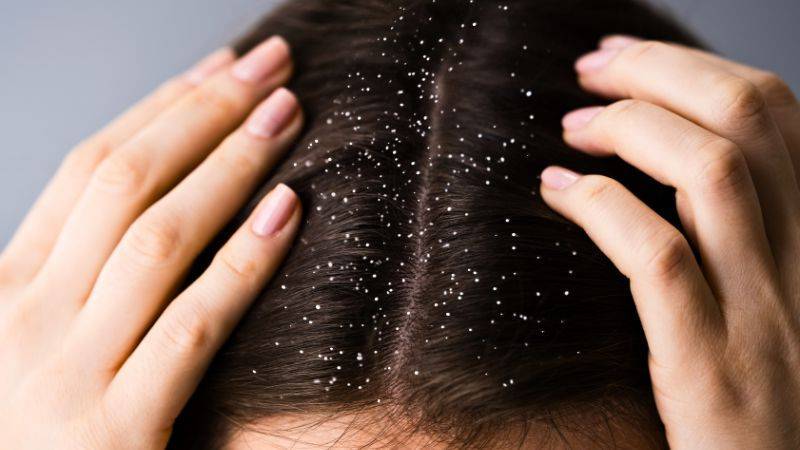Highlights
Characterized by itchy, white flakes on the scalp, dandruff can be both uncomfortable and embarrassing. It may also lead to symptoms like greasy scalp patches and tingling skin.
Despite being easy to treat and fairly common dandruff can result from factors like dry skin, seborrheic dermatitis, hair product sensitivity, and scalp fungus growth.
While numerous Over-The-Counter products target dandruff, natural remedies often prove equally effective.
Causes of Dandruff

Dandruff is a common scalp condition that can be caused by various factors.
Here are the steps outlining how it forms:
- Scalp skin cell turnover: The skin on your scalp, like the rest of your body, continuously sheds dead cells and regenerates new ones. This process usually goes unnoticed, as the shedding of dead skin cells is a natural occurrence.
- Clumping of dead skin cells: As the dead skin cells accumulate, they mix with the natural oils produced by your scalp, causing them to clump together and form visible flakes.
- Malassezia yeast growth: Malassezia is a type of fungus that naturally occurs on the human scalp. In some people, an overgrowth of this fungus can exacerbate dandruff.
- Inflammation: The irritation caused by oleic acid, seborrheic dermatitis or an allergic reaction to hair products, can lead to inflammation of the scalp. This inflammation further accelerates skin cell turnover, exacerbating dandruff.
- Itchiness and irritation: As dandruff worsens, itchiness, redness, and irritation can occur, causing further discomfort and prompting individuals to scratch their scalp, which may lead to further flaking and inflammation.
To manage dandruff, it’s essential to identify and address the underlying causes while adopting suitable treatments, such as medicated shampoos, natural remedies, or lifestyle changes.
Treatment Approach
The best treatment for seborrheic dermatitis (SD) and dandruff should focus on clearing the condition, quickly reducing itchiness, and maintaining long-term remission.
As Malassezia is the primary cause and inflammation results from its proliferation, common treatments include topical antifungal and anti-inflammatory agents.
Topical Treatments
Topical Antifungal Agents:
- Ketoconazole (2% shampoo, cream, gel, or foam)
- Miconazole (2% cream, gel, or powder)
- Bifonazole (1% shampoo, cream, or ointment)
- Selenium sulfide (2.5% shampoo, lotion, cream, foam, and suspension)
- Zinc pyrithione (1% shampoo)
- Ciclopirox olamine (1.5% shampoo, 1% cream, gel or lotion).
Ketoconazole, miconazole, and bifonazole are azole antifungals that work by stopping fungal cell wall synthesis.
Selenium sulfide acts as a cytostatic and keratolytic agent, with fungicidal properties against Pityriosporum ovale.
Zinc pyrithione increases cellular copper levels, interfering with fungal growth and metabolism.
Ciclopirox olamine disrupts multiple fungal cell activities by inhibiting metal-dependent enzymes.
Topical antifungals hinder Malassezia growth, preventing inflammation. Shampoos should be used 2 to 3 times a week for four weeks, depending on dandruff severity, and then once a week for maintenance.
The most common side effect is irritant contact dermatitis, affecting up to 10% of patients, with bifonazole causing the most irritation.
Selenium sulfide may cause orange-brown scalp discoloration in children, which is reversible and removable with an isopropyl alcohol swab.
Treatment failure with azole antifungals may occur due to resistant strains of M. globosa and M. restricta.
Topical Steroids
Steroids like
- Hydrocortisone (1% cream)
- Fluocinolone (0.01% shampoo, lotion, or cream)
- Betamethasone dipropionate (0.05% lotion)
- Desonide (0.05% lotion)
have been used. They work as strong anti-inflammatory agents but may cause skin atrophy, hypopigmentation, telangiectasia, hypertrichosis, and folliculitis with extended use.
Topical Keratolytic Agents
Urea and propylene glycol have keratolytic effects, while lactic acid has keratolytic and hydrating properties. All inhibit bacterial and/or fungal growth.
Studies have shown that a combination of these agents, when applied daily for 4 weeks, significantly improves erythema and scaling in mild to severe SD cases.
Topical Calcineurin Inhibitors
Tacrolimus (0.03% and 0.1% ointment) and pimecrolimus (1% cream) are used to treat SD.
They inhibit cytokine production by T-lymphocytes and have similar efficacy to topical steroids and antifungal agents.
However, prolonged use may lead to skin malignancy and lymphomas, so caution is advised.
Additional Treatments
- Metronidazole gel (0.75%, applied twice daily for four weeks) works as an anti-inflammatory agent by inhibiting free radicals, preventing oxidative tissue damage. It has shown similar efficacy and safety to ketoconazole 2% cream.
- Coal tar 4% shampoo, applied once or twice a week, has anti-inflammatory, keratolytic, and antifungal properties. It reduces sebum production, with scalp folliculitis and irritant contact dermatitis on fingers.
-
Lithium gluconate/succinate (8% ointment or gel, applied twice daily for eight weeks) acts as an anti-inflammatory agent, increasing IL-10 levels while reducing TLR2 and TLR4 in keratinocytes.
-
Narrowband UVB phototherapy (three times a week for eight weeks or until lesion clearance, with a cumulative dose of 9.8 J/cm2) works by inhibiting cell proliferation.
-
Licochalcone (0.025%), an extract from Glycyrrhiza inflate, has been found effective in treating infantile SD due to its anti-inflammatory and antimicrobial effects.
-
Antimicrobial peptides (AMPs) are part of the epithelium’s innate defense and are effective against M. furfur.
Known AMPs include cathelicidins, cecropin A (CA), and magainin 2 (MA). A modified synthetic AMP, P5, has shown potent antifungal action, 3 to 4 times more effective than ketoconazole or itraconazole against M. furfur.
Systemic Treatment Options
Itraconazole(100 mg twice a day for seven days)
Itraconazole works by inhibiting the enzyme lanosterol 14α demethylase, which is essential for fungal cell wall synthesis.
It also acts as an anti-inflammatory agent by blocking the synthesis of 5-lipoxygenase metabolites involved in various inflammatory disorders, including SD.
A dosage of 100 mg twice a day for 7 days, followed by 200 mg once a day for 2 days per month for 2 months, was effective in 83.3% of SD cases.
Although oral ketoconazole (200 mg daily for four weeks) has been used for SD treatment, it is more hepatotoxic compared to itraconazole.
Oral terbinafine is not effective against Malassezia, so it is not used for SD or pityriasis versicolor treatment.
Low-dose isotretinoin
A randomized, comparative clinical trial involving 45 patients over 6 months demonstrated that isotretinoin at a dose of 10 mg every other day effectively treats moderate to severe seborrhea and SD, particularly on the scalp and face.
There was a significant reduction in sebum secretion on the face and scalp within three months of starting therapy, indicating isotretinoin’s effectiveness in controlling sebum production and, in turn, reducing M. furfur colonization.
Natural Solutions for Eliminating Dandruff
A variety of natural remedies can also be employed daily to permanently banish this problem. To achieve this, it’s essential to gather the necessary ingredients and combine them correctly.
- Lemon infused Coconut Oil
- Camphor infused Coconut Oil
- Neem Extract
- Yogurt
- Orange Peel
- Green Tea
- Olive Oil
- Listerine mouthwash
- Garlic
- Tea-Tree Oil
However, there is no scientific evidence to prove these remedies significance.
Do not forget to do a patch test before applying any of them and always consult to Dermatologist to get the best use.
Role of Hair Brush in diminishing dandruff
Many people overlook the importance of their hairbrushes for maintaining scalp and hair health, but a scalp brush can indeed help reduce dandruff in several ways:

-
Removes scalp buildup: Dandruff often results from the accumulation of sebum and dead skin cells on the scalp. A scalp massager brush can help remove this buildup. Use small movements with the brush to prevent hair tangling.
-
Enhances shampoo effectiveness: Using a scalp brush while shampooing can improve cleansing and moisturizing. With the scalp buildup loosened or removed, the shampoo can work more efficiently to clean your scalp and reduce dandruff symptoms.
-
Stimulates the scalp and promotes hair growth: If hair loss due to dandruff is a concern, using a scalp massager brush 2 to 3 times a week during oiling or shampooing can promote blood circulation, leading to a healthier scalp and new hair growth. This process strengthens hair shafts and encourages the growth of thicker, more voluminous hair.
TIP:
While numerous home remedies for dandruff exist, in some cases, additional treatment may be required.
Many medicated shampoos and scalp treatments contain antifungal or antibacterial ingredients specifically designed to reduce dandruff.
If these products don’t yield results after 2-3 weeks, it might be helpful to consult a dermatologist to determine whether prescription shampoos or medications would be more effective.
Healthcare professionals often prescribe topical antifungal medications, corticosteroids, and immunomodulators to address dandruff and other skin conditions and dermatitis.
FAQ
1. Could a lack of vitamins at any point prompt dandruff?
A: Yes, research conducted by experts has shown that vitamin deficiencies can lead to a scaly scalp, dandruff, brittle nails, poor night vision, hair loss, and bleeding gums. Insufficient levels of vitamin B2, B6, vitamin B3, and zinc may contribute to seborrheic dermatitis.
To enhance your scalp’s health and reduce dandruff, consider incorporating foods like legumes, seafood, meat, nuts, dairy, and whole grains into your diet.
2. Is dandruff more normal during summer or winter?
A: Dandruff can develop at any point throughout the year, but it tends to be more prevalent during the winter months when the scalp becomes itchy and dry. This itching can result in flaking and the buildup of dandruff.
To prevent this, use a scalp massager brush to eliminate buildup, oil your scalp thoroughly, and wash your hair with a moisturizing shampoo two to three times a week.
Avoiding heat styling can also help preserve your hair’s natural moisture and reduce scalp dryness.
Also Read






